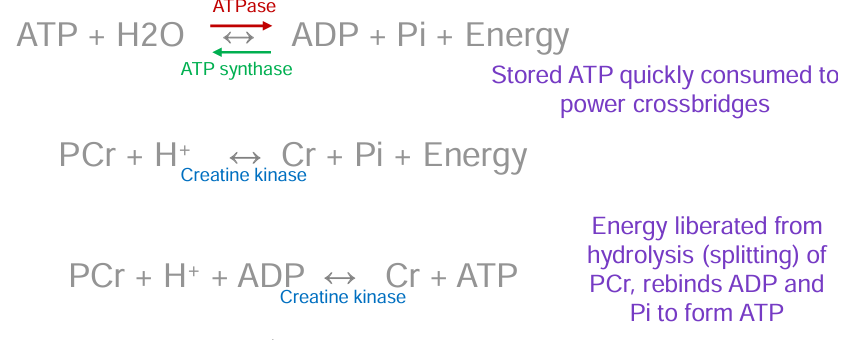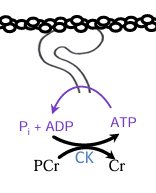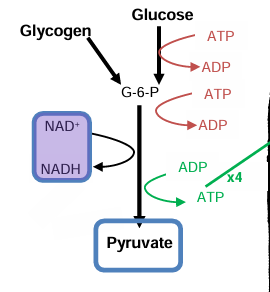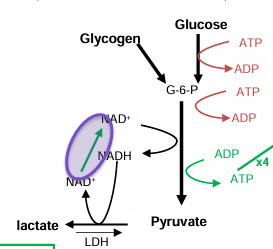Lecture 3- out in the cytosol
1/55
There's no tags or description
Looks like no tags are added yet.
Name | Mastery | Learn | Test | Matching | Spaced |
|---|
No study sessions yet.
56 Terms
Fiber type categorization and performance ability is dependent on
neuromuscular properties
Neuro muscular properties
electrical properties (neuro)
mechanical properties (muscualr)
metabolic properties (muscular)
Slower MUs are recruited before
faster MUs
Faster MUs activate faster than
Slower MUs
Faster MUs cycle
crossbridges faster than slower MUs
Slower MUs have lower anaerobic power but
greater aerobic supply than faster MUs
Conservation of energy
energy cannot be created nor destroyed rather it can only be transferred from one form to another
chemical work
synthesis of cellular molecules (forming ATP)
Mechanical work
muscles contraction (crossbridge power stroke)
Transport work
pump substances against concentration gradient to maintain concentrations (action potentials, Ca+, reuptake to SR)
Metabolism
Describes the sum of cellular processes
Anabolism
smaller molecules are combined to make larger molecules
requires energy in
forms or repairs tissues
storage of energy as bonds
Catabolism
larger molecules are broken down to make smaller molecules
breaks down food
cho
fats
protein
body tissues
fat
protein
bones
powering crossbridge strokes
requires energy ATP
but muscular ATP storage is low (6mmol/kg) and lasts 1-3 seconds
Hydrolysis
the breakdown of ATP into ADP and Pi
chemical bond is broken through addition of water (released energy needed for crossbridge cycling)
In muscle, ATP is used for
cross bridge power stroke
re-sequester calcium to SR (CA2 ATPase)
restore membrane resting NA and K balance
Limiting factors for metabolic processes
substrate availability
enzyme availability
Substrate (fuel) availability
more substrate results in faster rate (more reactions)
less substrates results in slower rate (fewer reactions)
enzyme availability
enzymes lower activation energy needed for a reaction
more enzymes results in more reactions result in more power
enzymes bind to substrates
Anaerobic energy sources
stored ATP
stored phosphocreatine
glycolysis
Aerobic Energy sources
oxidative (aerobic) phosphorylation
occurs in mitcohondria
Anaerobic
doesn’t require oxygen
occurs in cytosol
Aerobic
requires oxygen
occurs in mitochondria
Stored ATP (fuels, timeframe, by products)
ATP, 2s, N/A
Phosphocreatine (fuels, timeframe, by products)
CP, 0-20s, Cr and ATP
Glycolytic (fuels, timeframe, by products)
CHO, 15-120s, latic acid — atp — co2
Aerobic (fuels, timeframe, by products)
CHO — fats — protein, 120s-several hours, ATP — Co2
ATP floats
ATP is floating around freely to be used when needed
Sliding filament theory
Crossbridge formation and release of pi
Power stroke, ADP is released, myosin undergoes conformational change
ATP binds myosin, causing detachment of myosin from actin, cross bridge dissociates
ATP hydrolysis occurs, and myosin head cocks
ATP is available
fast, in very limited supply
Phosphocreatine
Phosphocreatine splits PCr+ADP → Creatine Kinase → ATP+Creatine
explain phosphocreatine
The enzyme Creatine Kinase hekps transfer a phosphate group (pi) from PCr to ADP which will form ATP again
ie. donation of bond energy and Pi from PCr to reform ATP from ADP
Bond based energy storage

Energy liberated from hydrolysis of PCr
rebinds ADP and Pi to form ATP

stored creatine is essentially
storable, easy to reverse, contains the same amount of energy as ATP bond
Glycolysis
partial breakdown of glucose through series of enzyme-driven fermentation reactions

Glycogenolysis
partial breakdown of glycogen through series of fermentation reactions

Glycolysis/glycogenolysis requires enzymes
requires glucose-6-phosphate to begin
conversion of glucose costs 1ATP
conversion of glycogen costs )atp
Steps to glycolysis
glucose is phosphorylated to form glucose-6 phosphate (consumes 1 ATP)
Glucose-6 phosphate is rearranged to form fructose 6-phosphate
Phosphorylation into fructose bisphosphate (1ATP)
Fructose bisphosphate gets turned into two three carbon molecules
Dihydroxyacetone phosphate (DHAP) is converted into glyceraldehyde-3-phosphate (G3P), so there are two molecules of G3P available for the next steps.
Each G3P is oxidized, and NAD+ is reduced to NADH. An inorganic phosphate is added, forming 1,3-bisphosphoglycerate
1,3-bisphosphoglycerate (1,3BPG) donates a phosphate group to ADP to form ATP and 3-phosphoglycerate (3PG)
3-phosphoglycerate (3PG) is converted into 2-phosphoglycerate (2PG).
2-phosphoglycerate (2PG) loses a water molecule, forming phosphoenolpyruvate (PEP).
Phosphoenolpyruvate (PEP) donates a phosphate group to ADP, forming ATP and pyruvate.
end product of gylcolysis
2 molecules of pyruvate
2 molecules of NADH
2 molecules of atp net gain
key steps of glycolysis
split into 3 C chains and each is converted to pryuvate
Profuction of H plus (step 6)
H binds to NAD and travels to ECT
ATP production through glycolysis
2 ATP per each 3-C chain
Net yield for glucose and glycogen (ATP
glucose: 2 ATP
glycogen 3ATP
glycolysis/glycogen
glucose needs to get converted to glucose 6 phosphaet (1ATP) but glucogen is good (0 ATP)

limiting factor for glycolysis
phosphofructokinase
What if there’s no where for pryuvate or NADH to go?
they accumulate
limited NAD prevents glycylosis
accumulation of pryuvate inhibits glycolysis
how to solve problem of pryuvate and nadh accumulation
conversion of pryuvate to lactate
reaction pyruvate to lactate

conversion of pryuvate to lactate enables
continued glycolysis

in the absence of oxygen we can exercise for
only 2 minutes
relying on stored ATP, PCr and Glycolysis
energy is required for
tissue building, membrane transport and muscle action
1 crossbridge =
1 ATP
energy for cellular process is stored as
phosphate bond in ATP
energy for muscle work is provided in
the cytosol
stored ATP
glycolytic breakdown (partial) of glucose
stored as a bond in PCr
cytosolic metabolism ends with
pyruvate — running out of gas